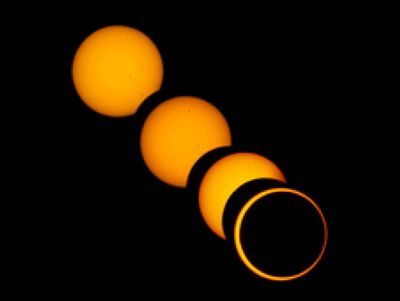Annular Eclipse on May 10
2013-05-11
This image sequence shows an annular solar eclipse from May 2012. The bottom right frame illustrates the distinctive ring, or "annulus," of such eclipses. A similar eclipse will be visible from the South Pacific on May 10, 2013.
Image courtesy Brocken Inaglory, via Wikimedia Commons .
On May 10, 2013, the sun experienced what’s called an annular eclipse -- when the moon moves directly in front of the sun, but doesn’t obscure it completely. This leaves a thin, fiery ring, the annulus, visible around the outside. This eclipse was only visible from the South Pacific, along an approximately 100-mile-wide track that traverses Australia, Papua New Guinea, the Solomon Islands and the Gilbert Islands. Other areas in Australia and Indonesia saw a partial eclipse, in which the moon blocks a much smaller region of the sun.
Annular eclipses occur at times when the moon is farther away from Earth, making it appear smaller, and not big enough to completely block the sun. While eclipses have long served as a way of observing the sun’s dimmer atmosphere at a time when the bright light of the sun is blocked, annular eclipses don’t provide much help with this kind of research, as the glare of the annulus overpowers any chance of seeing the atmosphere.
Eclipse observations take place with special telescopes, as even during an eclipse, one should never look directly at the sun.
Eclipse observations take place with special telescopes, as even during an eclipse, one should never look directly at the sun.
See the webside for more details: http://www.nasa.gov/topics/solarsystem/features/2013-annular.html (SY)

 Search
Search

